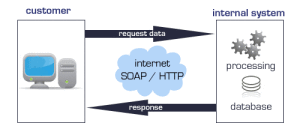Difference Between API and Web Service
 API vs Web Service
API vs Web Service
API and Web service serve as a means of communication. The only difference is that a Web service facilitates interaction between two machines over a network. An API acts as an interface between two different applications so that they can communicate with each other. An API is a method by which the third-party vendors can write programs that interface easily with other programs. A Web service is designed to have an interface that is depicted in a machine-processable format usually specified in Web Service Description Language (WSDL). Typically, “HTTP” is the most commonly used protocol for communication. Web service also uses SOAP, REST, and XML-RPC as a means of communication. API may use any means of communication to initiate interaction between applications. For example, the system calls are invoked using interrupts by the Linux kernel API.
An API exactly defines the methods for one software program to interact with the other. When this action involves sending data over a network, Web services come into the picture. An API generally involves calling functions from within a software program.
In case of Web applications, the API used is web based. Desktop applications such as spreadsheets and word documents use VBA and COM-based APIs which don’t involve Web service. A server application such as Joomla may use a PHP-based API present within the server which doesn’t require Web service.
A Web service is merely an API wrapped in HTTP. An API doesn’t always need to be web based. An API consists of a complete set of rules and specifications for a software program to follow in order to facilitate interaction. A Web service might not contain a complete set of specifications and sometimes might not be able to perform all the tasks that may be possible from a complete API.
The APIs can be exposed in a number of ways which include: COM objects, DLL and .H files in C/C++ programming language, JAR files or RMI in Java, XML over HTTP, JSON over HTTP, etc. The method used by Web service to expose the API is strictly through a network.
Summary:
1. All Web services are APIs but all APIs are not Web services.
2. Web services might not perform all the operations that an API would perform.
3. A Web service uses only three styles of use: SOAP, REST and XML-RPC for
communication whereas API may use any style for communication.
4. A Web service always needs a network for its operation whereas an API doesn’t need
a network for its operation.
5. An API facilitates interfacing directly with an application whereas a Web service is a
- Difference Between Droid 1 and Droid 2 - July 21, 2011
- Difference Between VLAN and LAN - July 20, 2011
- Difference Between Mazda 3 and 6 - July 20, 2011
Search DifferenceBetween.net :
 Email This Post
: If you like this article or our site. Please spread the word. Share it with your friends/family.
Email This Post
: If you like this article or our site. Please spread the word. Share it with your friends/family.


really gr8 explanation of difference i`m happy and understood 🙂 thanks again
good explanation
Very Good explanation
Nice to read..
Nice basic understanding of the concept
Couldn’t have been a simpler way of explaining this. Thanks so much!
Fantastic explanation!!!
Very nice and up to point explanation. Great job. Thanks
Could Not find better explanation than this. Thank you for writing
Wonderful and Clear Explanation. Solves the intended purpose of differentiating API vs Web Service.
Thank you.
great explain
That is an amazing work !
Thank you so much for your time
Good Job Manasa, Well explained and understood the concept of webServices and API in ten mins while reading this article..Thanks for posting good stuff.
very well expalined
Well, explained!
Rather straight forward up to bullet point #5 which reads:
“5. An API facilitates interfacing directly with an application whereas a Web service is a”
A Web service is a….what?
Difference between API and Webservices
1. All Web services are APIs but all APIs are not Web services.
2. Web services might not perform all the operations that an API would perform.
3. A Web service uses only three styles of use: SOAP, REST and XML-RPC for communication whereas API may use any style for communication.
4. A Web service always needs a network for its operation whereas an API doesn’t need a network for its operation.
5. An API facilitates interfacing directly with an application whereas a Web service interacts with two machines over a network.
6. Web service is like advanced Urls and API is Programmed Interface.
7. API contains classes and Interfaces just like a program.
8. A web service is a form of API (Application Programming Interface).
9. An API is used by a computer programmer to establish a link between software applications. This interface can take several forms, a web service is just one of these.
10. There are several types of web service. SOAP (Simple Object Access Protocol) is one of the most common. The API takes the form of a service description (WSDL) which is used to automatically generate the program code which makes the connection.
Cheers..!!
Great post, thanks for posting
Clear Explanation
Thank for Sharing
Great explaination !
Thanks for sharing.
Thank you for this article 😉
Good explanation..
How fantastic explanation this.
Thank you, so well explaned.
Cheers
Thanks , exactly what I was looking for. Very well explained.
Crystal clear explanation! Thanks a ton!!
You have amazingly explained the complex concept of APIs and WS, in a very simpler manner. Thanks!
Thank you
Simple and Nice Explanation !!!! Keep posting
Good explanation
I need to understand to create new api through java.
this is awesome